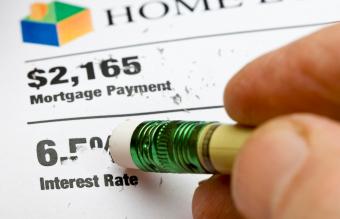
Homeowners sometimes take out second mortgages to gain access to cash to fund home improvements or to make major purchases. A second mortgage is "a type of subordinate mortgage made while an original mortgage is still in effect."
Understanding Second Mortgages
A second mortgage is not the type of mortgage you take out when you purchase a home. A second mortgage becomes an option when you have owned your home long enough to build up equity in the property that you are then able to borrow against. These types of loans are sometimes referred to as home equity loans.
Determining Amount
If you have equity in your home and want to turn that equity into cash, you can take out a second mortgage. You could have equity as a result of making payments on the existing mortgage over a period of time or as a result of an increase in the market value of your home (or a combination of both).
Lenders that provide second mortgage loans look at the difference between the balance on your first mortgage and what the home is worth, and they will consider loans for a portion or all of that amount. To get an idea of how much you can borrow, you will need to determine the amount of equity in your home.
Lien Order
When you purchase a home using a mortgage, that loan is the first (or primary) lien on the home. If you were to stop making payments on your home and the property ended up being sold off in a short sale or as a result of a foreclosure, funds from the sale would first go toward your primary mortgage. The lender that provided you with a second mortgage would be next in line to receive proceeds from the sale.
Since the second mortgage lender is not the first lien, there is more risk associated with this type of loan than with a first mortgage. As a result, the interest rate on a second mortgage is typically higher than the current going rate for new first mortgage loans.
Alternatives to Second Mortgages
There are a few other financial products you may want to consider if you are looking for a way to access the equity in your home. Depending on your situation, a second mortgage can be the best option. Or, you may want to consider a home equity line of credit (HELOC) or cash out refinancing.
HELOC Option
A second mortgage provides you with a lump sum amount of cash at the time of closing, which is a primary difference between this type of loan and a HELOC. While you can convert home equity to cash with both a second mortgage and a HELOC, the manner in which you access funds is different. With a second mortgage, you receive a single lump sum of cash up front, while with a HELOC, you are approved for a line of credit that you can draw against when you need to do so. There are other differences between second mortgages and HELOCs, as well, including variations in closing costs, interest rates and how interest is calculated.
Cash Out Refinancing Option
Cash out refinancing is another option for gaining access to the equity in your home. With this option, you take out a new loan that replaces your existing mortgage. Therefore, it becomes a new first primary loan, rather than a secondary loan in a subordinate position.
Make an Informed Decision
Whether you opt for a second mortgage or a different type of financial product that provides you with funds in a somewhat similar way, it is important to research your options thoroughly. Talk to a few mortgage lending experts to get a sense of which option will be best for you and shop around for the most favorable terms.







